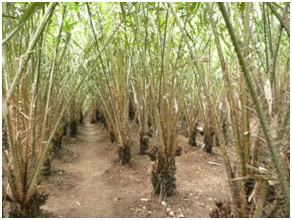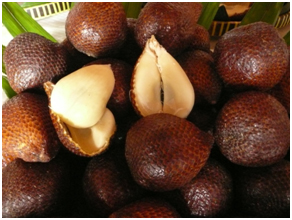What is salacca fruit?
Salacca is a tropical fruit that grows from a very spiny, short stemmed palm. The fruit grow in bunches at the base of the plant.

The individual fruits are the same size and shape as a fig. The fruit’s skin is covered with brown scales giving the appearance of a snake or reptile skin.

The Import Risk Analysis process
[expand all]
Why is this risk analysis being undertaken?
Indonesia would like to send fresh salacca fruit to Australia. The Department of Agriculture received this request in 2011.
The objective of this risk analysis is to ensure that any salacca fruit received in Australia is free from unwanted pests and diseases.
An IRA is a process that identifies any unwanted pests and diseases that might be on Indonesian salacca fruit and are not present in Australia. The process is completed in accordance with the Quarantine Regulations. Australia determines the level of risk that cannot be exceeded if we want to protect Australia’s environment from unwanted pests and diseases – this is called Australia’s Appropriate Level of Protection (ALOP).
The risk analysis checks whether the risk of pests and diseases on Indonesian salacca fruit is above or below this level.
The report is based on the latest available science and reflects Australia’s conservative approach to managing biosecurity risks.
What unwanted pests and diseases have been identified?
Four pests of potential concern have been found. Three are mealybugs (small, sap-sucking insects) and one is a plant disease caused by a fungus.
Will Australia be adequately protected from the unwanted pests and disease?
The report found that the overall risk for these pests and diseases does not exceed Australia’s ALOP.
The growing, packing, and shipping practices used by Indonesia ensure that these pests and diseases do not arrive in Australia.
In particular:
- Indonesia has a national standard for Good Agricultural Practices. This includes specific Standard Operating Procedures for growing, managing pests, harvesting, packing, and inspection of salacca fruit Indonesia sends overseas.
- These procedures ensure that salacca fruit sent overseas is undamaged, clean and free from any pests, soil and other plant materials.
- Orchards growing and packing houses packing salacca fruit for Australia must be registered with and audited by Indonesian authorities.
- Indonesian agricultural quarantine officers will inspect the fruit and certify that it is free of pests and diseases Australia does not allow.
Salacca fruit imports and exports
[expand all]
Does Australia currently allow any imports of fresh salacca fruit?
The importation of fresh salacca fruit is currently not permitted from any country.
Does Australia export fresh salacca fruit?
No. Although the salacca palm is occasionally grown in northern Australia, there is no local industry producing salacca commercially.
Australia's food standards
[expand all]
Does imported food need to comply with Australia’s food standards?
Imported food for human consumption must satisfy Australia’s food standards. Australian law requires that all food, including imported food, meets the standards set out in the Australia New Zealand Food Standards Code.
Food Standards Australia New Zealand (FSANZ) is responsible for developing and maintaining the Code. The standards apply to all food in Australia, irrespective of whether it is grown domestically or imported.
Consultation
[expand all]
Have stakeholders been consulted?
The department consulted with stakeholders before starting this analysis, and throughout the process, so they could raise any concerns.
The draft report was released for public comment on 6 February 2014. Three submissions were received, and were considered in the preparation of the provisional final IRA report.
Appeals process
This report is published for a 30 day appeal period. Any appeals are considered by the Import Risk Analysis Appeals Panel (IRAAP), which is independent of the department.
[expand all]
How can an appeal be lodged?
Written appeals should be submitted by 29 November 2014 to:
Secretariat
Import Risk Analysis Appeals Panel
Corporate Policy Division
Department of Agriculture
GPO Box 858
CANBERRA ACT 2601
Email: IRAAP
Who considers the appeal?
The appeals panel is convened by the Chair of the Biosecurity Advisory Council (BAC). The IRAAP Chairman will consider any appeals received and decide in each case whether the statement of reasons provide evidence warranting consideration by an IRAAP. If so, they will convene a panel to consider the appeal(s). The other members are:
- another member of the BAC (nominated by the Chair); and
- a senior officer from the Department of Agriculture (nominated by the Secretary of the Department).
How long will it take for an appeal to be considered?
The appeals panel has 45 days after the closing date for appeals to consider its findings and report to Australia’s Director of Animal and Plant Quarantine.
What happens if an appeal is upheld?
If an appeal is upheld, the IRAAP may offer advice to the department. The IRAAP will consider the appeal(s) and report its findings to the appellant(s) and the Director of Animal and Plant Quarantine.
What happens if the final policy is adopted?
The Director of Animal and Plant Quarantine provides guidance for granting import permits, and the department is responsible for implementing the policy.
Does this give the go-ahead for Indonesia to send salacca fruit to Australia?
No, Indonesia does not automatically send salacca fruit to Australia because the final policy is adopted.
Fruit is not imported until someone wants to receive salacca fruit from Indonesia. In this case, the Department of Agriculture will need to issue an import permit under the guidance of the Director of Animal and Plant Quarantine.
The department will ensure that the quarantine conditions and processes for the safe imports of this fruit are in place before trade can begin.
